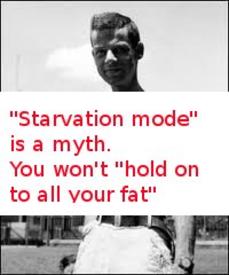Spreadsheet for BMR/TDEE Deficit, Macro calcs, HRM zones
Replies
-
In 1A. Activity Level calculator (Katch or Mifflin BMR multiplier based on studies WHO, Durnin, and Bubb), what are you supposed to put in the area designated for "Sedentary"? Should I enter in the number of my BMR x 1.25? Or should it automatically give me a number after I enter every other activity in?
When I put the minutes/hours of my activity, am I supposed to mulitply them to the numbers directly to their right in the next box, and then re-enter them into the middle box? Or what are the numbers at the far right for? Forgive me for asking so many questions...I think I'm a few fries short of a happy meal when it comes to things like this. :ohwell: Is 1A more accurate than the 1B? I don't have a HRM or fitbit:noway: , so I'm not doing 2 or 3...
Most of that info is there just so you know what is happening, outside trying to read the formula in the cell.
I figure that way folks that are semi-familiar with this method, or who check another website, can see the exact same multipliers or methods are being used, nothing flaky is going on.
For 1A, those multipliers, I just wanted to copy the method the other TDEE calc shows, where the multiplier is stated. Most sites using that Harris TDEE calc show the multiplier, so thought it was interesting.
So, if that Sedentary line on 1A doesn't have a value in there already, the formula got deleted.
As well as the other lines. As soon as you enter a value, the daily calorie increase based on that time will appear.... like magic! Well, maybe not. If not there, download a fresh copy then.
The value for Sedentary should match your BMR x 1.25 though, in case you feel like getting out calculator and confirming.
I think 1A is more accurate. Not only based on more recent studies than 1919, but the fact you can enter in time of activity at different levels, and harder work than desk job.
On the traditional TDEE calc used in 1B, the following always cause confusion and bad guessing happens. Comes up in the topic posts again and again.
What if you work as a nurse on your feet constantly, and lift 3 hrs a week? What level?
Is 5 hrs of spin bike class and running fast equal 5 hrs of walking? What level then?
Is 4 hrs of exercise the same no matter what the routine is, and select Moderately Active?
Is easy 3 hrs rounded down, hard 5 hrs rounded up? What about hard 3 and easy 5?
The full blown version of that 1A TDEE calc is used on the Future You tab, is is a bit of homework thinking about your weekly routine to such a detailed degree, so I just included the important work levels and exercise levels, and assumed sedentary for a base start.0 -
Hope it's proving useful.
Now, how do I close the older thread for older ver that has starting post missing some details?0 -
Bump0
-
Use the "Report thread" feature, select other, and ask for it to be closed in the text box ?Now, how do I close the older thread for older ver that has starting post missing some details?
Can you put a version number close to the start of future thread titles to ensure it's noticed perhaps ? rather than falling off the right hand end.0 -
bump0
-
Use the "Report thread" feature, select other, and ask for it to be closed in the text box ?Now, how do I close the older thread for older ver that has starting post missing some details?
Can you put a version number close to the start of future thread titles to ensure it's noticed perhaps ? rather than falling off the right hand end.
Well, thank you much, that should help.
That HRM one I'd like to tweak to in order to emphasis the setting HRmax first as biggest effect, other stuff later, if even needed at that point.
And that one with the study of Polar and inaccuracy with default values - that study is gone from everywhere now that I've looked. Never seen that happen. I've got my saved copy, but wondering if a company can really get like court order to remove something they don't like, or if some major flaw in it was found so pulled.0 -
marking to read later0
-
Thanks so much! The thing I alsays found hard to do was estimate my fat %, because I don't have a scale capable of it, or callipers (student life = too broke to buy some). The usual estimations didn't take enough measurements into account, and my BF % would always be way higher than I knew it was because I have a pretty muscular frame... so it was nice to get a better estimate through this. :flowerforyou:0
-
Hi.
I've now downloaded version 3 but with either version I am not looking at the TDEE figures, only the BMR. This is because, as you put it on the MFP tweak tab, my workouts are "iffy or irregular". So other than inputting my stats into the BMR/TDEE tab (and now using its BF calculator) I stay away from the rest of that tab.
So my question is still, given my high BF%, can I eat less than the Katch-McArdle BMR figure?
4+ weeks of no progress is really getting to me!!
Ah, now i remember, maybe.
So the bigger part of the equation - how are you determining calories burned to eat back?
Is the estimate for bodyfat between the 2 equations close? If not, you may have body type that doesn't do estimates well from measuring. Should be within 5%, if not, the BMR differences can be pretty decent sometimes.
Because Katch BMR is actually already underestimated when you are overweight, it is only using LBM for BMR calc, and actually your bodyfat does take energy to maintain fluid levels in, not as much at healthy weight, but it counts when overweight.
So it's actually likely, you are not eating enough. Hence the new spreadsheet there does the 20% deficit instead of starting at BMR level, which is walking you too close or under the line of benefiting fully from your workouts.
When you ask if the estimated BF% is close, I assume you are referring to the two values on the spreadsheet ie the US Navy version and the Covert Bailey version? No, the difference is more than 5% - its 13%.
Determining calories burned is via HRM - Polar F11. Its own VO2max (Fitness test) gets really weird results - in fact according to it I've gotten LESS fit in the last 3 months!?! I did one of the Shapesense VO2max tests and based my VO2max on that. (I do need to redo it though since its been at least 5 weeks since I last did it).
As for eating more calories - at the 1606 that the spreadsheet has had me at (before extra for exercise if appropriate) I do not feel AT ALL hungry (I've never been good at depriving myself so I'm not just saying this!) Using the 20% deficit amount on the spreadsheet takes me back to the same figure as BMR (which is probably why I referred to eating less than the BMR amount.)
FWIW if I let MFP set my goals it gives me a lower goal (1400)...?0 -
When you ask if the estimated BF% is close, I assume you are referring to the two values on the spreadsheet ie the US Navy version and the Covert Bailey version? No, the difference is more than 5% - its 13%.
Determining calories burned is via HRM - Polar F11. Its own VO2max (Fitness test) gets really weird results - in fact according to it I've gotten LESS fit in the last 3 months!?! I did one of the Shapesense VO2max tests and based my VO2max on that. (I do need to redo it though since its been at least 5 weeks since I last did it).
As for eating more calories - at the 1606 that the spreadsheet has had me at (before extra for exercise if appropriate) I do not feel AT ALL hungry (I've never been good at depriving myself so I'm not just saying this!) Using the 20% deficit amount on the spreadsheet takes me back to the same figure as BMR (which is probably why I referred to eating less than the BMR amount.)
FWIW if I let MFP set my goals it gives me a lower goal (1400)...?
Ahh, I'm not going to leave you in the lurch for VO2max stat - check out the HRM tab, it's in there. The formula was found more accurate than sub-maximal tests were actually.
If you let your HRM get your restingHR first thing in the morning with that test, it would probably come up with this or close.
VO2max won't change much outside the first 1-4 months of starting exercise. Past that, it's minor unless doing some very specific training to enhance it.
So with a BF% spread of that much, measurements are not going to be the most accurate estimate. One may be a whole lot more accurate than the other. Then again, might use both values and see if it really changes the end result that much and by how much.
So indeed, for amount to lose right now, 20% deficit is appropriate. And if selecting Sedentary as non-exercise daily activity, then correct you end back up at BMR.
Is Sedentary correct? Most folks using FitBit and BodyMedia discover Lightly Active is more correct if not still low. Something to thing about.
Now, the MFP goal should also probably end up being set a tad higher. Because to get MFP to use your better estimated BMR, you have to fiddle with those 2 values to end up close to the same amount, but always over as buffer.
So indeed, sounds appropriate that goal is at BMR right now.
MFP is starting with different BMR and allowed deficit.0 -
Bump
Definitely want to check this out!0 -
For activity level: I have been using lightly active for the last month and that might be part of my problem. The more I think of it, the more I think sedentary is the correct setting for me: my job literally is watching TV / computer screens.
Ahh, I'm not going to leave you in the lurch for VO2max stat - check out the HRM tab, it's in there. The formula was found more accurate than sub-maximal tests were actually.
If you let your HRM get your restingHR first thing in the morning with that test, it would probably come up with this or close.
VO2max won't change much outside the first 1-4 months of starting exercise. Past that, it's minor unless doing some very specific training to enhance it.
So with a BF% spread of that much, measurements are not going to be the most accurate estimate. One may be a whole lot more accurate than the other. Then again, might use both values and see if it really changes the end result that much and by how much.
So indeed, for amount to lose right now, 20% deficit is appropriate. And if selecting Sedentary as non-exercise daily activity, then correct you end back up at BMR.
Is Sedentary correct? Most folks using FitBit and BodyMedia discover Lightly Active is more correct if not still low. Something to thing about.
Now, the MFP goal should also probably end up being set a tad higher. Because to get MFP to use your better estimated BMR, you have to fiddle with those 2 values to end up close to the same amount, but always over as buffer.
So indeed, sounds appropriate that goal is at BMR right now.
MFP is starting with different BMR and allowed deficit.
I checked out your HRM tab and if I use PAS level 4 then it makes a difference of 118 calories to my total of exercise calories burned for the week - not a huge difference so I don't think that's the issue.
Thanks for all the input; I'm going to try mix up the goals a bit for a few weeks and see how it goes. I'm also going to try and up my water some more to see if that helps.
Thanks again!0 -
Listen to this man, he knows his ****. Thanks for the new spreadsheet sir - was just considering doing another tweak.. mind reader!0
-
WOW -- an amazing amount of work, time and energy put into this. Thanks for putting it out there and allowing the rest of us to benefit from this. I was easily able to download the file and save it. Can't wait to poke around in it and see what it means for me.
Thanks again!0 -
WOW -- an amazing amount of work, time and energy put into this. Thanks for putting it out there and allowing the rest of us to benefit from this. I was easily able to download the file and save it. Can't wait to poke around in it and see what it means for me.
Thanks again!
Thank you much.
Half the effort was to make it easier for me just to run numbers helping folks, and my own personal use of course.
Then kept seeing questions about using the other nice sites that dealt with one thing or another, but none let you log your stats, so just kept making improvements.
To the point now, it's hard to go back and look at a formula and remember how I did what I did.
Let me know what you think.0 -
I think 1A is more accurate. Not only based on more recent studies than 1919, but the fact you can enter in time of activity at different levels, and harder work than desk job.
:laugh: LOL...when you put it that way...
Thanks for your time and effort into this! I've already started eating at my "new" maintenance calorie level, and I'm confident this is more in tune to my daily expenditure.0 -
I think 1A is more accurate. Not only based on more recent studies than 1919, but the fact you can enter in time of activity at different levels, and harder work than desk job.
:laugh: LOL...when you put it that way...
Thanks for your time and effort into this! I've already started eating at my "new" maintenance calorie level, and I'm confident this is more in tune to my daily expenditure.
Welcome.
If you have been eating well below that new goal for a while, such that you weren't losing weight, you might want to only increase calories by 200 a day for a week. Then another week, ect.
Allows metabolism to increase without you going so far over what is really your current TDEE, if you stalled anyway.
And to maintenance? Doing reset then? As you slowly increase calories, might hang an extra week at the deficit amount and see if you start losing anyway what is expected.0 -
bump0
-
I am happy to see this thread again as I used your calculator last week! Wanted to say a big thank you
 0
0 -
bump0
-
bump0
-
bump0
-
bump and thanks!!!!0
-
Bump0
-
bump0
-
bump0
-
bump0
-
bump- was going to recheck my numbers after being stalled for 3 months0
-
bump0
-
Bump0
This discussion has been closed.
Categories
- All Categories
- 1.4M Health, Wellness and Goals
- 398.1K Introduce Yourself
- 44.7K Getting Started
- 261K Health and Weight Loss
- 176.4K Food and Nutrition
- 47.7K Recipes
- 233K Fitness and Exercise
- 462 Sleep, Mindfulness and Overall Wellness
- 6.5K Goal: Maintaining Weight
- 8.7K Goal: Gaining Weight and Body Building
- 153.5K Motivation and Support
- 8.4K Challenges
- 1.4K Debate Club
- 96.5K Chit-Chat
- 2.6K Fun and Games
- 4.8K MyFitnessPal Information
- 18 News and Announcements
- 21 MyFitnessPal Academy
- 1.5K Feature Suggestions and Ideas
- 3.2K MyFitnessPal Tech Support Questions



















